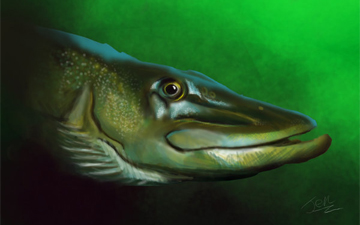The northern pike (known simply as a pike in Britain, Ireland, or as jackfish in Canada and in the United States of America Esox lucius), is a species of carnivorous fish of the genus Esox (the pikes). They are typical of brackish and freshwaters of the northern hemisphere (i.e. holarctic in distribution).
Northern pike are most often olive green, shading into yellow to white along the belly. The flankis marked with short, light bar-like spots and there are a few to many dark spots on the fins. Sometimes the fins are reddish. Younger pike have yellow stripes along a green body, later the stripes divide into light spots and the body turns from green to olive green. The lower half of thegill cover lacks scales and they have large sensory pores on their head and on the underside of the lower jaw which are part of the lateral line system. Unlike the similar-looking and closely related muskellunge, the northern pike has light markings on a dark body background and fewer than six sensory pores on the underside of each side of the lower jaw
(From Wikipedia, March 1, 2011)
– – –
Pike spawn from the end of March to the beginning of May, usually in quite shallow water and often using the same places year after year. The spawning process can last several weeks and the number of eggs varies with the age and size of the female. A large fish may produce as many as half a million eggs. The eggs are sticky and adhere to plants, the young pike hatching after 10 – 15 days. At this stage they have no proper mouthparts and remain attached to the plants until the yoke sac is consumed. Once the young fish become free-swimming, they feed mainly on small organisms, but once they reach a length of 5 cm, they begin preying on other fish larvae and tadpoles. Once they have survived these early stages, pike grow fast, sometimes reaching a weight of one kilogram in the space of three years. Males mature at the age of two, females at four years. Pike catch their food largely by stealth and lightning-fast acceleration, taking their prey unawares. A large adult pike will eat roach, rudd, dace and perch, trout and salmon, and even other members of their own species. They will also take frogs, newts, crayfish and they have been known to catch ducklings and small mammals.
(From ARKive.org via EOL)




